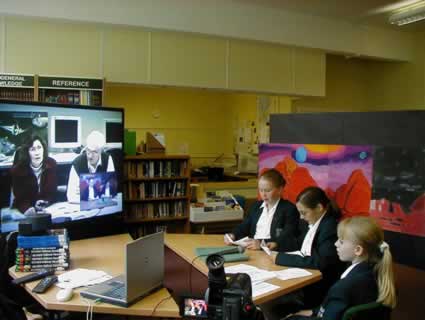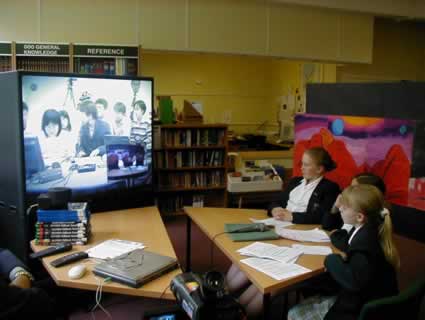An international, cross-curricular exploration of Space Science, through on-line learning tools
International | Africa | Bangladesh | Chile | China | CzechMiranda | Japan | Macedonia | Mexico | MiraNet | MirandaNorth | Poland | Regional | Star | Thailand | UK-Japan Science | UK-China Links | USA
STAR | Presentation | Article | Integrated Web Sites | Online Discussions | Taiwan

An international, cross-curricular exploration of Space Science, through on-line learning tools
This is the presentation which Lawrence Williams (UK) and Ruth Petersen (USA) made in Seattle, May 2003
The New ICT Learning Model
At the Holy Cross School, science input for this project came from a number of sources:
In the United Kingdom:
- the study of NASA data, through the STAR web site (in ICT lessons)
- oral presentations by the Year 7 students themselves, as a means of sharing their NASA science research (in English lessons)
- the use of school science text books (in Science lessons, and for homework)
- science lessons, on the chemistry of life; gravity
From the United States
- the study of detailed scientific notes, added by Joe, via email, into the students’ PowerPoint and Word files (in English and science lessons)
- commentary and analysis of Joe’s science fiction story “The Once and Noble Race” (in English lessons)
- video-conferencing with Joe (question and answer session about science problems)

Starting point: Kelly, aged 11 years, can be seen working on obtaining recommended NASA data, through the NASA STAR web site.
![]()

Lizzie and Joy (aged 11 years) are showing their PowerPoint presentations to students at Ikeda Junior High School, Osaka, Japan. This demonstrates the musical aspects of STAR.
![]()

The Ikeda students, in Osaka, Japan, watch the PowerPoint stories unfold with great interest.
![]()

This is what the Japanese students could actually see. Lizzie and other Holy Cross students showed her entire PowerPoint stories, over a sequence of conferences.
![]()

In reply, a week or so later, the Ikeda students played the music which they had kindly composed especially for us. The Ikeda High School’s laptop was used to play the music files. One example file is now posted on the introductory page of STAR.
![]()

This is one group, called 7T, my Music and ICT class. They are working in the Kells Library.
![]()

The 7T students had previously sent Joe science questions, by email, and here he is answering them by video-conferencing.
![]()

Joe also showed the Holy Cross students photographs of the surface of Mars. Here, he is teaching them about the formation of river valleys on Mars. This information fed directly into Katie’s Mars science fiction story.
![]()

More questions were answered by Joe on what we might find on Mars. These ideas were developed in moral education lessons. How would we treat life, if we found it ? What institutions would we build as part of a Mars colony?
![]()

Finally, Katie and Louise present the story “Mars, Lost and Found” live to Glenn LTP, against a backdrop of art work, also added as part of the cross-curricular studies at Holy Cross. Students used pastels, paint, and collage, and worked in groups of six.
- the internet, for the research of NASA science data from the STAR web site
- word-processing of their stories
- PowerPoint presentations from laptops, to Japan
- Emails to Joe, with Word and PowerPoint attachments
- WordArt
- clip art
- sound files
- animation
- music files from the internet
- video-conferencing with Japan, for the musical collaboration, and with the NASA, for the science information, and detailed commentary from Joe Kolecki

This slide captures much of the process. Behind Louise, Katie and Emily is the Art work. They are reading Katie’s word-processed science fiction story, “ Mars Lost and Found”. The video-conference camera is on top of library books (also used). On-screen are Ruth and Joe, listening to the story (our outgoing picture of the girls is on the “inset screen”). In Japan and in the USA, students are also listening, live and the story is also being webcast. On the table, left, are the mouse to operate the laptop (which showed JPEGs of the work at Holy Cross; the TV controller; and the VC camera controller. At the front of the picture is a movie camera, to record the event.
![]()

This shot shows an American school’s PowerPoint slide, as seen in London!
![]()

This shows the Ikeda students’ presentation of their work, also as seen in London.
![]()
NASA scientific data passed through the minds of the students, by the use of the web, email and video-conferences with Joe at NASA, and was transformed from Science into Art, as narrative, art, and music.

Go to the Holy Cross School Integrated Web Site for more information.
[Back]

